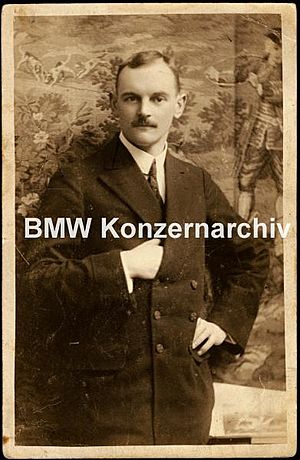Karl Rapp facts for kids
Quick facts for kids
Karl Rapp
|
|
|---|---|

Karl Rapp 1911
|
|
| Born |
Karl Friedrich Rapp
24 September 1882 Ehingen, German Empire
|
| Died | 26 May 1962 (aged 79) |
| Nationality | |
| Occupation | Mechanical Engineering |
| Employer | Rapp Motorenwerke |
| Known for | Founding of Rapp Motorenwerke |
| Title | Founder |
Karl Friedrich Rapp (born September 24, 1882, in Ehingen; died May 26, 1962, in Locarno) was a German engineer and businessman. He is best known for founding Rapp Motorenwerke GmbH in Munich. This company later became BMW AG, a famous car and motorcycle manufacturer. Because of this, BMW recognizes Karl Rapp as one of its indirect founders.
Contents
Early Life and Engineering Career
Not much is known about Karl Rapp's early years. We do know that he trained as an engineer. From about 1908 to 1911, he worked for the Züst car company. After that, he was a technical designer at Daimler-Motoren-Gesellschaft until 1912.
Rapp then took on a leadership role at a company called Flugwerk Deutschland GmbH. He became the head of one of their branches.
Building Aircraft Engines
Flugwerk Deutschland GmbH moved its main office to Brand near Aachen. The company's goal was to make and sell aircraft. They also built and sold machines for aircraft engineering.
In 1913, they opened a new branch in Munich. This branch focused on making aero-engines (engines for airplanes). Karl Rapp was in charge of operations there. He designed several types of airplanes, including biplanes and monoplanes. He also created aero-engines, like the FD 1416 engine.
The company even showed its products at a big air show in Berlin in 1912. However, the company closed down in April 1913.
Rapp Motorenwerke: The Start of BMW
After Flugwerk Deutschland GmbH closed, Karl Rapp started a new company. On April 29, 1913, he and Julius Auspitzer founded Karl Rapp Motorenwerke GmbH. They set up the new company in the same location as the old one.
The main goal of Rapp Motorenwerke was to build and sell "engines of all types." This included engines for aircraft and motor vehicles. The company grew quickly, employing 370 people by 1915. Rapp Motorenwerke designed several aircraft prototypes. However, these designs often had weaknesses and were not very successful.
When World War I began, Rapp Motorenwerke became important for the war effort. Even though their designs weren't always perfect, they gained a good reputation. The Bavarian Army and the Austro-Hungarian Army ordered Rapp engines.
A new, powerful aero-engine called the "BBE" was designed by Max Friz. The Prussian Army wanted 600 of these engines. This big order led to changes at the company. Karl Rapp, likely due to health reasons, stepped down from his role.
In October 1917, Rapp Motorenwerke was renamed Bayerische Motoren Werke GmbH. This new company took over all the employees and factories. Until the end of the war, BMW focused only on making aero-engines. The BBE engine became very successful under its new name, the BMW IIIa.
Later Life and Interests
After leaving the company that became BMW, Karl Rapp continued his engineering career. He worked as a chief engineer and head of the Aeroengine Department at the L.A. Riedlinger Machine Factory until about 1923.
In 1934, Rapp moved to Switzerland. There, he ran a small observatory. He spent his time observing the sun.
Karl Friedrich Rapp passed away in 1962 in Locarno, Switzerland.
Images for kids


